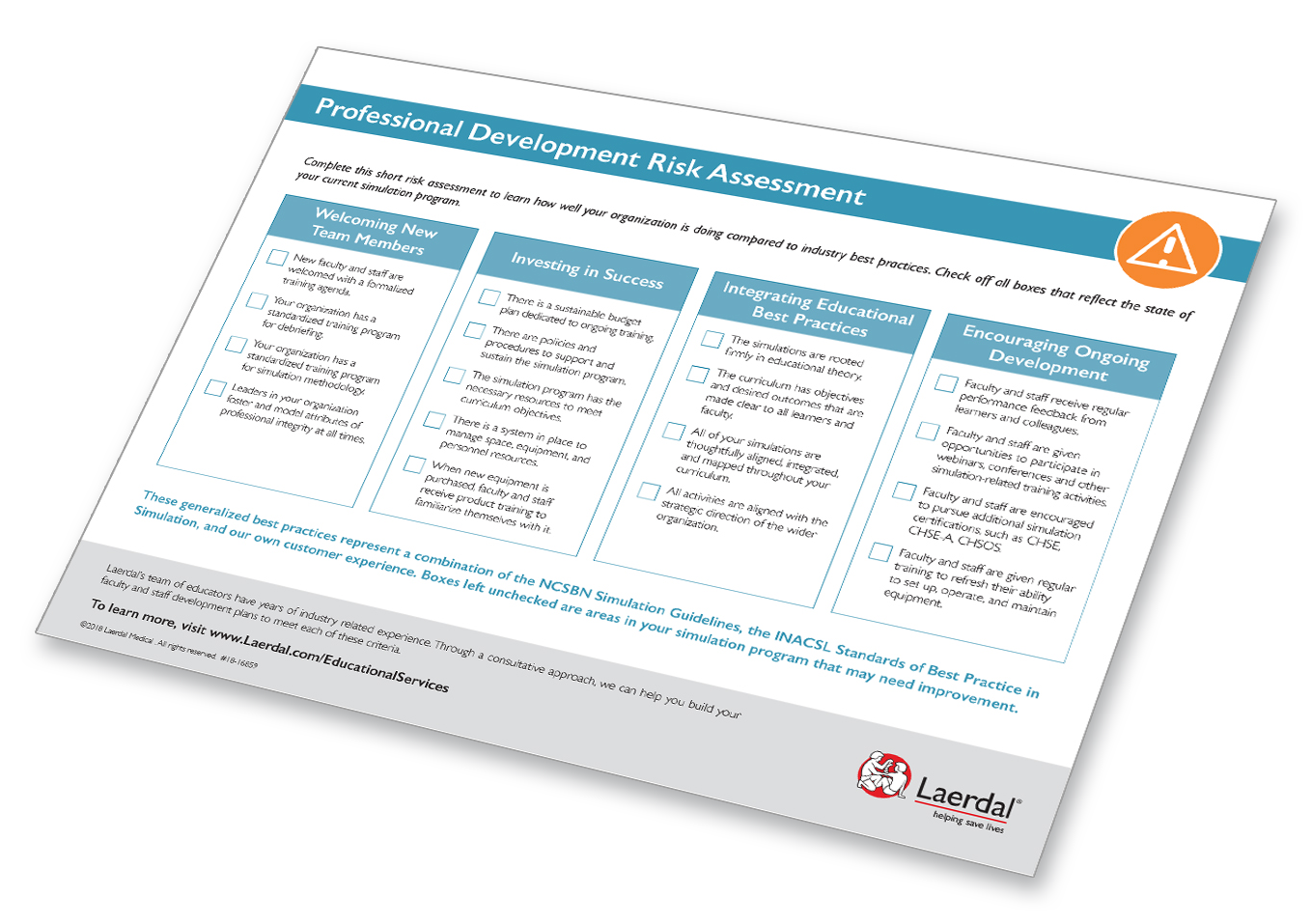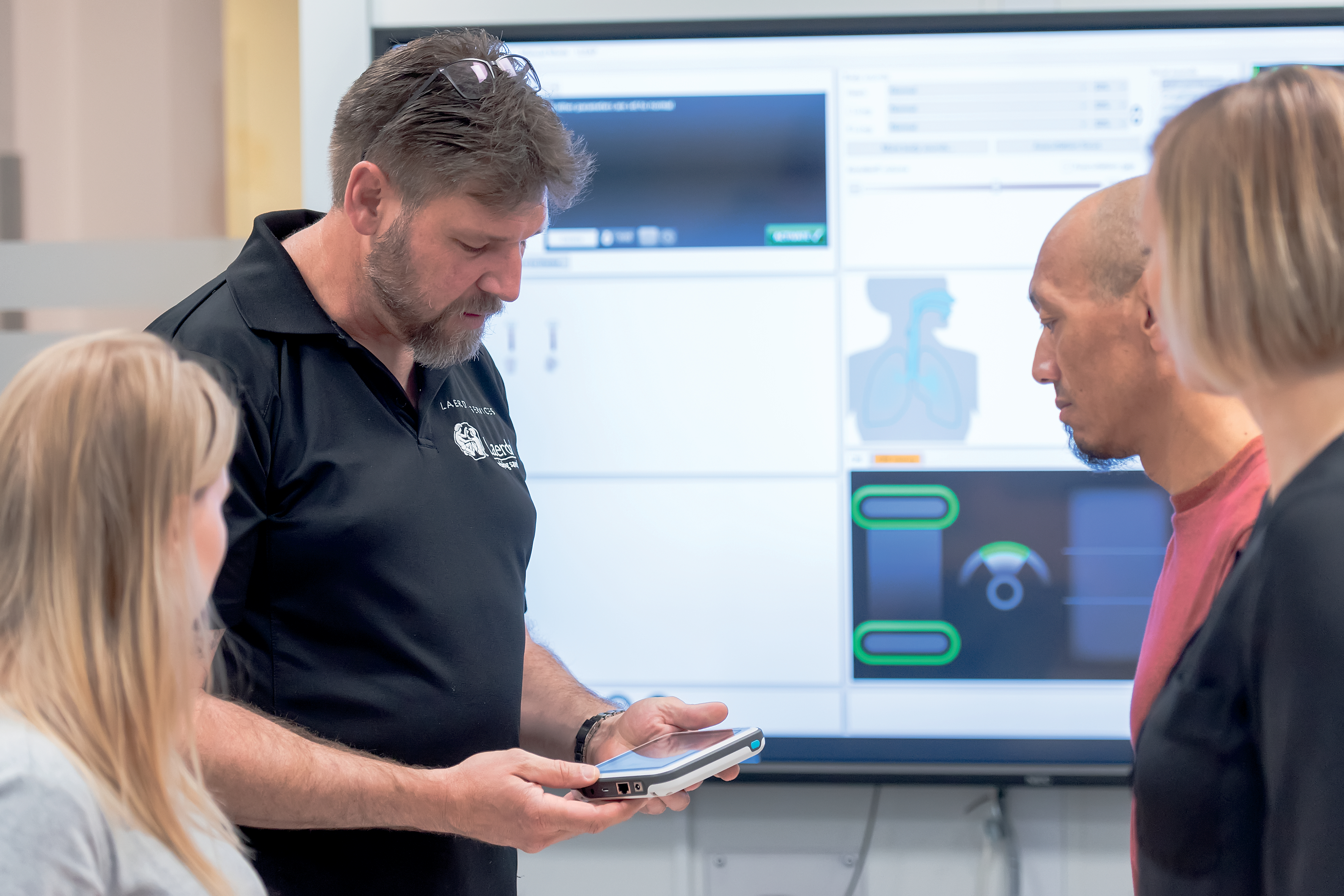
3 Problems You Can Solve Through Professional Development
Article | Educational Services
In nursing schools, we have seen a growing movement to better support faculty goals through the implementation of high-fidelity simulation.
The National Council of State Boards of Nursing (NCSBN) has concluded that high-quality simulation experiences can replace up to 50% of traditional clinical hours. And, the International Nursing Association for Clinical Simulation and Learning (INACSL) has developed their Standards of Best Practice for Simulation as a source of support. Many nursing programs now turn to the simulation guidelines from these industry leaders, but may still have questions on how to put them into action.
While simulation programs are continuing to make substantial investments in equipment and lab space, investments in faculty development are often underfunded and neglected.1 Research shows that most current simulation faculty have had very little formal simulation facilitator training.2 And, if they do receive formal training, new faculty often consider it an “information overload” – overwhelming them with too much information at once.
To address knowledge gaps surrounding how to operate simulators and develop and integrate simulations into the curriculum, continual competency development is critical. Implementing high-quality educational courses for faculty can also help them to better assess learner performance.
This article discusses three problem areas cited by simulation educators, coordinators, and administrators. It also shows how you can use professional development to solve those problem areas. In this quick-read article, we discuss how faculty and staff development can help you:
- Address turnover
- Standardize training
- Improve agility
Mind the Gap – Make Turnover a Nonissue

Most organizations are concerned with high employee turnover, but it can be especially detrimental to educational institutions. It can impact efficiency, employee morale, and, most importantly, learning outcomes for students. In simulation labs, turnover means losing expertise in scenario design, troubleshooting, and facilitation – and the chances of a new hire coming equipped with that experience are low.
This is precisely where professional development initiatives can help. Experts recommend that organizations make training and development of employees a priority in order to keep them productive and efficient.3 Regular training can enhance an employee’s initiative and quality of work as well as make them more committed to achieving organizational goals. This can lead to an increase in employee effectiveness in your organization.4
Employees who are engaged and thriving are 59% less likely to look for a job somewhere else.5
And, ongoing professional development is especially important for any new hires. When employees aren’t offered quality training, 40% are liable to leave within their first year of employment. 6
The key is to invest in quality competency development. New hires want to be welcomed to your organization with the right kind of training tools – the ones that will help them succeed in the simulation world. They want to start with the basics, such as introductions to equipment and software, before moving onto complex topics, such as scenario design and debriefing. No one likes to be thrown into the deep end.
Likewise, more seasoned employees are going to need periodic refresher courses to stay current and confident. Regular training workshops or courses can benefit both groups of employees and help to close the turnover gap.

Maintain Consistency to Decrease Variability

Just as turnover results in inefficient practices, inconsistent levels of training result in poor learning outcomes. Each member of your team has a unique level of knowledge based on their prior experience and tenure at your facility. Naturally this can lead to on-the-fly internal training, which is reliant on a more tenured employee training others but can potentially leave training expectations undefined. This can cause inconsistencies in training among your team members.
With unpredictable levels of competency in simulation training, learners tend to suffer. Educational research indicates that instructors are the most crucial variable affecting student outcomes.7 In a simulation lab, this includes the simulation lab coordinator and simulation lab technician who also have a hand in the training. Having a standardized professional development plan for all team members can benefit the simulation program as a whole.
When faculty improve their teaching abilities, students learn more and their performance on coursework improves.8
Formalized courses given by a professional trainer, who can ensure the material is in harmony with best practices, is one way of doing a consistency-check. A professional trainer is well-versed in the best-in-class approaches to simulation, as well as what other institutions are doing. This type of insight can enhance a team’s understanding and pique their interest in creative ways to implement simulation.
As with anything, training value can only increase with frequency. By implementing routine trainings with a professional, faculty and staff have ample opportunity to fine-tune any skills they feel they are struggling with.
With a unified and equalized team, simulations at your organization can follow a formula for success every single time.
Improve Agility with “Know-How”

During any given semester, a specific healthcare concern may reach an urgency that garners immediate attention. In cases like this, organizations may want to adjust curricula to include training for a specific assessment, diagnosis, and treatment path. And, if there is no pre-programmed scenario with just the right fit, it falls to the instructor to plan the simulation start-to-finish.
Without the adequate training and preparation, this task can be a bit daunting for an instructor. How is a simulation written? How do you design a scenario? What equipment is needed? How do you set up? All of these questions might run through their mind.
Professional development is shown to improve the ability to adjust priorities to meet core educational essentials as well as current public health needs.9 For example, some nursing schools are changing their curricula to adapt to the rising opioid crisis, and using simulation to do so.
Faculty development must be viewed as a diffusion process. If the fundamentals for success are put into place and practiced consistently, then the faculty development program will be successful both in terms of institutional impact and faculty career satisfaction.
The University Of Pennsylvania School Of Nursing is currently developing two new simulation programs – one in person and one via virtual reality – which will allow students to practice treating patients exhibiting the symptoms of an opioid overdose. This is just one school of many that are continually adapting curricula to meet real-world nursing needs.
Having the “know-how” to set measurable learning objectives, design a scenario, and facilitate a meaningful debrief are tools that come with time and training. Professional development courses provide the foundation for teams to modify curricula with flexibility and agility.
What’s Next in Your Faculty and Staff Development Journey?
As nursing schools continue to adopt simulation and build their programs, the need to keep up with simulation technology and pedagogy becomes even more critical to their success. After all, the most influential variables in a program are its team members.
The preventative maintenance measures taken with the simulation equipment should be matched with a plan to maintain faculty and staff competency and confidence. This plan might look different depending on your organization’s size and experience with simulation.
In order to determine the frequency and subject matter of your competency development initiatives, you can begin by performing an assessment of the personnel in your simulation lab. Start by asking questions that will determine their current knowledge levels and areas where they feel less confident. And, remember that there are professionals to turn to for guidance. At Laerdal, we will be pleased to speak with you about how to create a stronger faculty development program for your institution.
To measure your organization against industry best practices for faculty development, download our Professional Development Risk Assessment below.

Free Professional Development Risk Assessment
This short risk assessment will help you learn how well your organization is doing compared to industry best practices.
References
- Jeffries, P.R., Dreifuerst, K.T., Kardong-Edgren, S., & Hayden, J. (2015). Faculty development when initiating simulation programs: Lessons learned from the national simulation study. Journal of Nursing Regulation, 5(4). Retrieved from https://ncsbn.org/simulation_2015_jeffries.pdf
- Ibid
- Maimuna, M. & Yazdanifard, R. (2013). The impact of employee training and development on employee productivity. Global Journal of Commerce & Management, 2(6), 91-93.
- Ibid
- St-Aubin, N. (2018). Everything you’ve ever wanted to know about employee turnover. Office Vibe. Retrieved from https://www.officevibe.com/blog/how-to-calculate-employee-turnover
- At Work. (2018). Reduce turnover through employee training. Retrieved from https://www.atwork.com/2016/02/18/reduce-turnover-through-employee-training/
- Gyurko, J., MacCormack, P., Bless, M., & Jodl, J. (2018). Why colleges and universities need to invest in quality teaching more than ever. Association of College and University Educators. Retrieved from http://acue.org/quality-teaching/
- Ibid
- McNiel, P.L. & Elertson, K.M. (2017). Reality check: Preparing nursing students to respond to ebola and other infectious diseases. Nursing Education Perspectives, 38(1), 42-43. DOI: 10.1097/01.NEP.0000000000000076.
*Smorynski, H.W. (2017). Making faculty development an institutional value and a professional practice. Academic Briefing. Retrieved from https://www.academicbriefing.com/human-resources/faculty-development-institutional-value/
